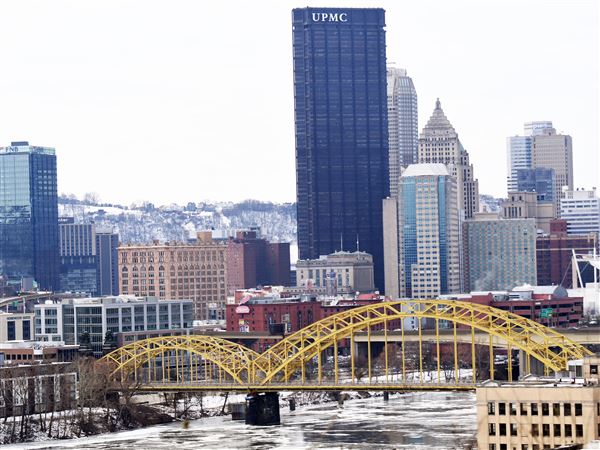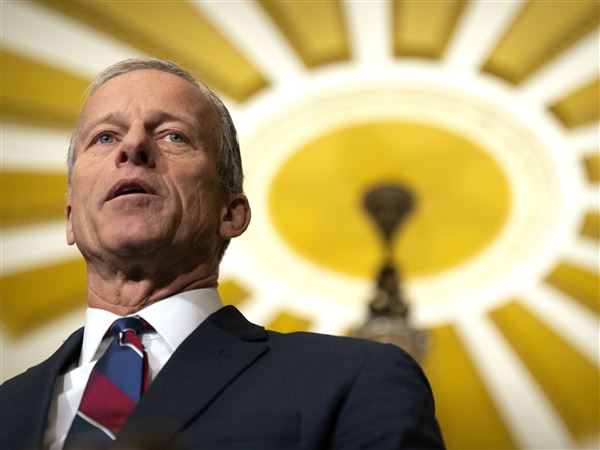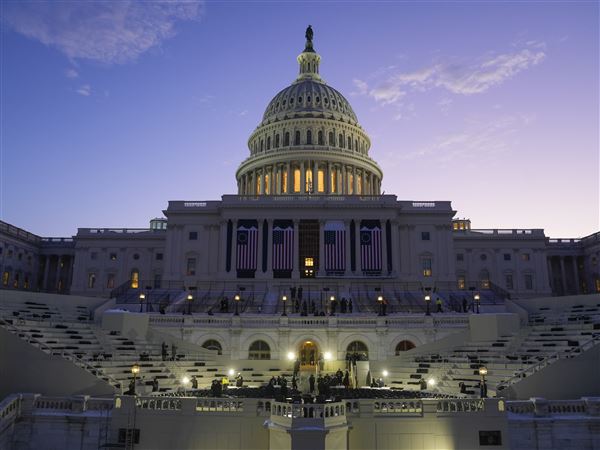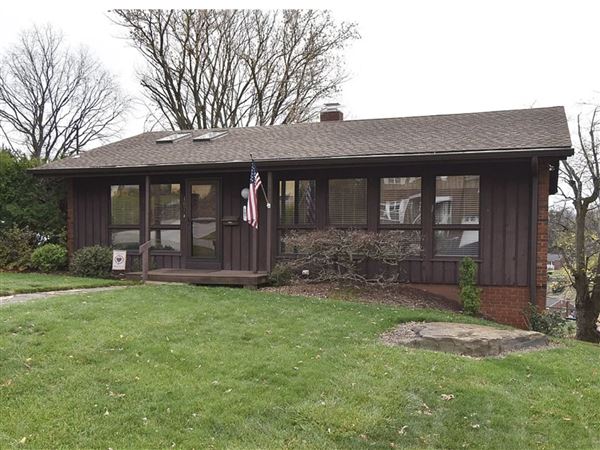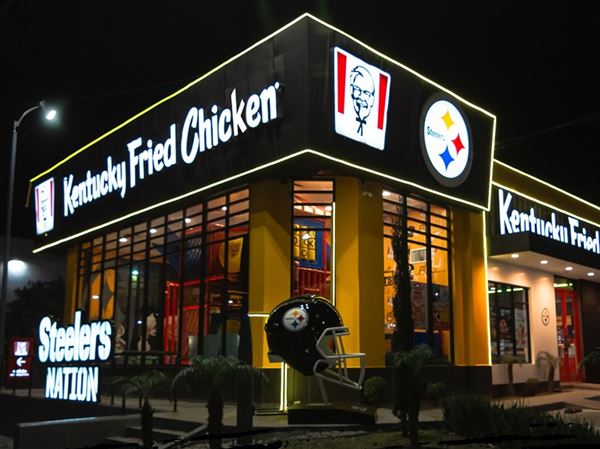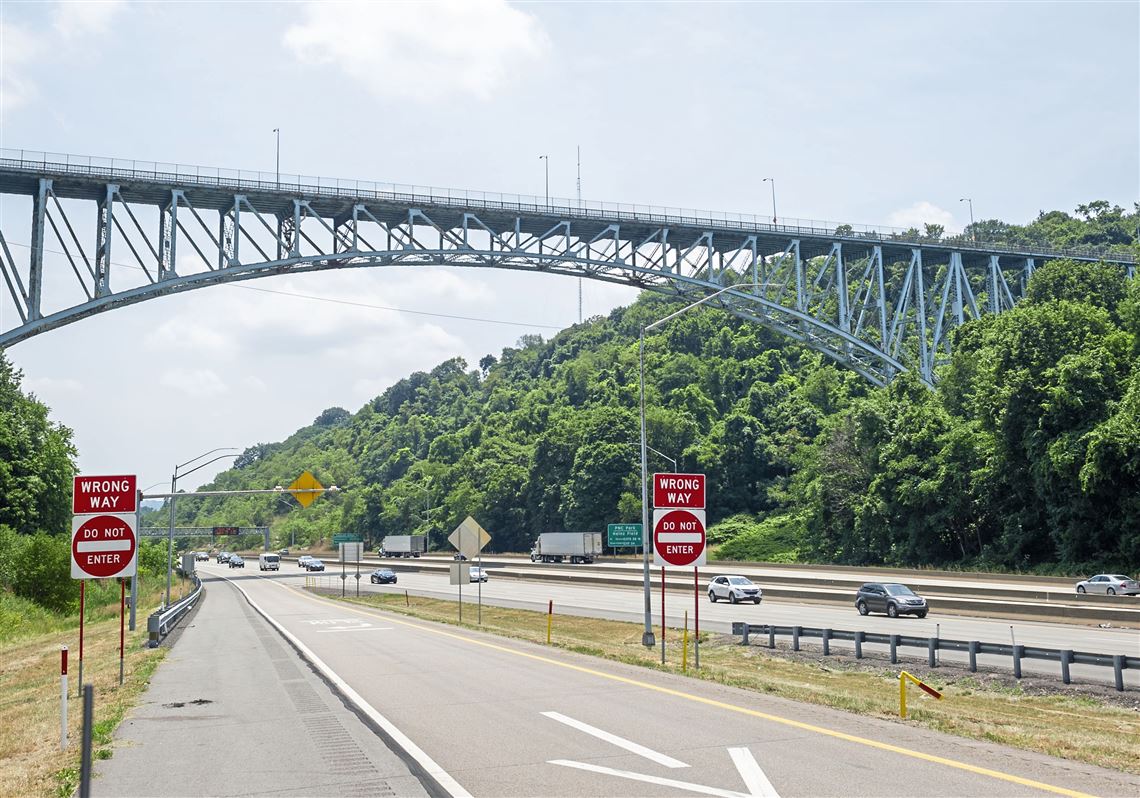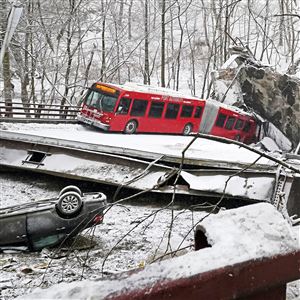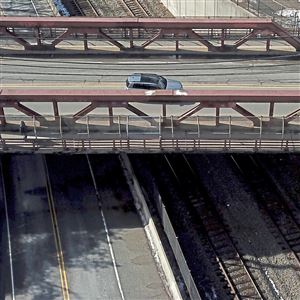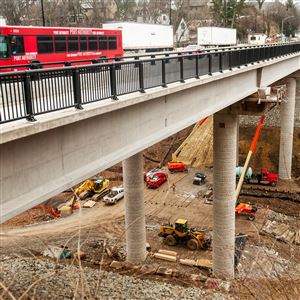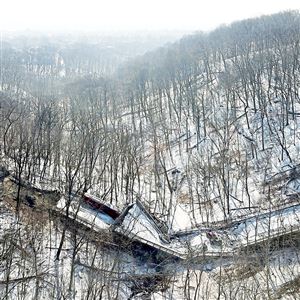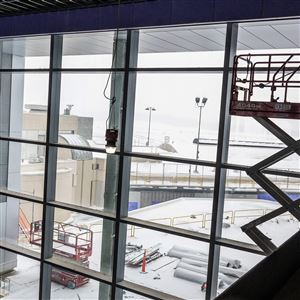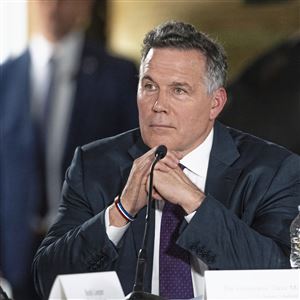Rush hour had only just passed, and with it the tens of thousands of cars that speed along the Parkway North daily as it winds through the steep, tree-lined valley separating the hilltop neighborhoods of Perry South and Spring Garden.
High above the busy thoroughfare on that early July day last year, the Swindell Bridge, a soaring arched span of steel and concrete, began shedding pieces of itself. They tumbled as far as 170 feet, reaching dangerous speeds before crashing onto the eight-lane highway below.
For more than a decade, officials knew the bridge posed a danger, both to those on it and the far greater number who pass below it every day. Inspectors gave it a poor rating as far back as 2009, but the bridge’s deterioration is apparent even to someone zipping along at highway speeds more than 100 feet underneath it. Creeping patches of dark rust eat away the light-blue paint on the steel trusses that suspend the massive structure over Interstate 279, one of Pennsylvania’s most heavily traveled and economically vital roads.
The Swindell Bridge is one of 32 city-owned spans rated in poor condition, according to a report Mayor Ed Gainey commissioned after the spectacular collapse of the Fern Hollow Bridge a year ago Saturday.
Yet a full year after Fern Hollow’s failure sent cars, a sport utility vehicle and a city bus tumbling into a snowy ravine, not one of those dozens of decaying bridges is scheduled to begin rehabilitation in 2023 under a key government infrastructure program, according to a Pittsburgh Post-Gazette review of public records.
The soonest rehabilitation project for any of the bridges won’t begin until next January, when officials expect to begin accepting construction bids to replace the Swinburne Bridge connecting Oakland and Greenfield, according to planning documents for the Southwestern Pennsylvania Commission. The 10-county cooperative decides which local infrastructure projects receive critical federal and state funding through the region’s Transportation Improvement Program.
Despite the passage of a $1.2 trillion federal infrastructure bill passed last year — a law heralded by President Joe Biden during a Pittsburgh visit the very morning of the Fern Hollow collapse — only 11 of the bridges identified in Mr. Gainey’s report as being in poor condition are scheduled to be rehabilitated or replaced in the next five years under the Transportation Improvement Program.
The Swindell Bridge — which the city shut down for two months after it rained debris onto I-279, and which today serves as the main route for at least one Pittsburgh fire station to get to Perry South — won’t even go out to bid until late 2026.
The remaining 21 city-owned bridges in poor condition aren’t on the five-year schedule at all.
“If you want to know [local leaders’] priorities, look at your municipal budget because that will show you the choices your local officials have made,” said John Brenner, the former mayor of York and current executive director of Pennsylvania Municipal League, a nonprofit that advocates for local governments.
A Post-Gazette investigation last year revealed wide disparities in which governments get their bridge projects funded with the federal and state dollars that are necessary for large, expensive infrastructure projects. Among the key findings: The state takes care of its own, while Pittsburgh-owned bridges are left to languish, often for years.
City-owned bridges were repaired at a slower pace and remained in poor condition for far longer than their state-owned counterparts, the investigation found. From 2012 to 2022, the state made enormous headway on its spans within the city, reducing the number rated in poor condition by 90 percent, while the number of Pittsburgh-owned bridges in the same condition remained unchanged.
Experts say that’s partly because the state, which is the main conduit for federal dollars, simply has more money.
Local governments rarely get all the funds they need directly from the giant pool of state and federal resources. Instead, it first passes through Harrisburg, then gets doled out to organizations like the Southwestern Pennsylvania Commission. There, representatives from local and county governments compete to have their most important projects added to the five-year Transportation Improvement Program.
Even within that program, local officials have to weigh their bridge-repair needs — and there are thousands of locally owned bridges just in this region — against everything from improving dangerous intersections to repaving pockmarked streets.
“The current TIP has a number of city bridges that have been prioritized by the city of Pittsburgh (to the tune of about $55 million),” Southwestern Pennsylvania Commission spokeswoman Shannon O’Connell wrote in response to Post-Gazette questions.
Mr. Gainey’s administration will get another chance to ask for more bridge funding starting in July, when the commission begins its next update of its five-year plan, Ms. O’Connell said.
The mayor did not respond to questions about the number of crumbling bridges that are, at best, years away from repair, or whether he thought spans such as the Swindell Bridge would remain safe for drivers and first responders during all that time.
Even if Mr. Gainey gets more of the city’s crumbling bridges on the list of future projects, there’s no guarantee the money will get there in time. After inspectors downgraded the Fern Hollow Bridge’s condition to poor in 2011, officials put it on a waitlist for public dollars that never arrived.
At the same time, millions of dollars were earmarked for Glenwood Bridge, a structure just 3 miles from the doomed span that is owned by Allegheny County and never got Fern Hollow’s dismal rating. Bidding on that project is scheduled for August.
Meanwhile, Pittsburgh-owned bridges that are already in dangerous condition continue to deteriorate.
Work on the Larimer Avenue Bridge, which had to be wrapped in protective fabric to keep its crumbling concrete from crashing onto busy Washington Boulevard, isn’t scheduled until July 2025. The Charles Anderson Bridge, another poorly rated span which carries a key artery across a ravine into Schenley Park, goes out for bid two months later, according to Southwestern Pennsylvania Commission documents.
At least 50 other bridges across the region whose conditions are considered fair or good are set to receive $200 million in funding, the Post-Gazette investigation found. A PennDOT official told the PG at the time that the agency, a key player in deciding which projects receive funding, spends money on better-rated bridges to prevent them from deteriorating into poor condition.
But the fact that so many locally-owned bridges remain in such poor condition for so long raises questions about the effectiveness of the complex system for funding infrastructure upgrades — and has some calling for a simpler solution.
“Send the money directly to the municipality,” Mr. Brenner said.
“If you look at the American Rescue Plan, for the first time that money came directly from the federal government to the municipalities,” Mr. Brenner said, referring to the almost $2 trillion stimulus passed in the early days of the Biden administration. “That made a huge difference, because then local officials could decide what to do with the money.”
Those officials even had the option of using some of the cash to cover portions of their infrastructure needs, Mr. Brenner said. But the rescue plan, designed to be a quick shot in the arm for local economies reeling from the worst pandemic in a century, “is not a long-term solution,” Mr. Brenner said.
“That money’s going to run out in a couple of years,” he said.
Mr. Brenner said he expects the pace of badly needed repairs to pick up as more and more of the massive infrastructure funding authorized by Congress last year becomes available. But Pittsburgh will still be competing with every other municipality, where local officials face the key test of figuring out which crucial project to try to push to the front of the line.
“It would be great to have that money come directly to us,” Mr. Brenner said. “But the reality is, on the infrastructure side, that we do have to work through this process.”
Mike Wereschagin: mwereschagin@post-gazette.com; @wrschgn
First Published: January 27, 2023, 4:36 p.m.
Updated: January 28, 2023, 12:38 p.m.
